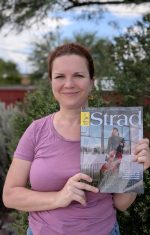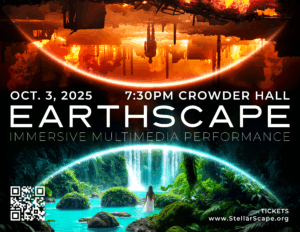
Faculty Research
Special Collections
For a list of collections maintained by the school and to request materials, visit the Special Collections & Archive Page
Professional Organizations

We are proud to announce that Dr. Elena Chernova‑Davis, concertmaster, educator, and soloist, has published an article, “A Riddle Inside An Enigma,” in the esteemed The Strad magazine. This publication highlights her continued contributions to violin performance and scholarship, cementing her reputation as both a distinguished musician and a leading educator.
Biber’s Mystery Sonatas continue to inspire and fascinate modern violinists, particularly for their unique use of scordatura — non-standard tunings that expand the expressive possibilities of the violin. In her article, Dr. Chernova‑Davis examines these cryptic 17th-century masterpieces from both theoretical and practical perspectives, shedding light on their technical innovations, symbolic depth, and enduring influence on performance practice.
Dr. Chernova‑Davis brings a remarkable career to her research. As a soloist and chamber musician, she has performed at prestigious venues including Carnegie Hall and Alice Tully Hall. Her experience as a concertmaster and educator informs her insights, bridging the gap between scholarly study and real-world performance.
Her article is available in the October 2025 issue of The Strad and can be accessed online here: Read “A Riddle Inside An Enigma” here: The Strad. We encourage readers to explore her work and join us in congratulating Dr. Chernova‑Davis on this significant professional achievement.
Learn more about Dr. Chernova‑Davis and her work on her professional website.
EarthScape: Professor YuanYuan (Kay) He’s Immersive Journey Through Planetary Time and Human Emotion
On October 3, 2025, audiences will enter Crowder Hall for EarthScape, a groundbreaking multimedia performance by composer and multimedia artist Professor YuanYuan (Kay) He. Combining electroacoustic music, interactive visuals, light, and dance, the work transcends the boundaries of traditional performance to explore planetary history, human emotion, and our shared responsibility for Earth’s future.
From Stardust to Stewardship
EarthScape tells the story of two Earth-like planets—one flourishing, one collapsing—whose fates mirror the resilience, vulnerability, and choices of humankind. Parallel to these planetary narratives is the intimate story of two individuals navigating connection, separation, and survival. Through allegory, the work engages themes of climate evolution, human impact, and the urgent role of stewardship in a fragile world.
A Continuum of Cosmos and Creation
This performance builds on Professor He’s previous multimedia project, StellarScape, which transformed the life cycle of a star into an immersive artistic experience. Where StellarScape was cosmic and expansive, EarthScape is rooted and urgent, shifting the lens from galaxies to geology, from stars to survival.
Interdisciplinary Collaboration
At the heart of EarthScape is interdisciplinary research and collaboration. The project brings together the University of Arizona School of Music, Department of Astronomy, Arizona Astrobiology Center, Live and Immersive Arts, School of Dance, and School of Information. These partnerships ensure that scientific knowledge and artistic practice are woven together, producing a work that is as intellectually rigorous as it is emotionally resonant.
Through interactive technologies, motion-reactive lighting, real-time visual art, and electroacoustic scoring, the performance blurs the lines between disciplines—transforming scientific concepts into sensory experiences.
A Multimedia Meditation for Our Time
In an era defined by climate crisis and rapid technological change, EarthScape serves as both an artistic meditation and a cultural provocation. It reflects Professor He’s ongoing research into the intersections of art, science, and technology, and demonstrates how creative work can illuminate urgent questions about humanity’s place in the cosmos and our responsibility to the planet we call home.
For more on Professor He’s interdisciplinary research and her previous work, visit StellarScape.org.

Watershed Soundscape is an interdisciplinary initiative led by the University of Arizona’s Arizona Institute for Resilience that merges watershed science with music, visual art, and cultural education to promote environmental awareness and community engagement. Rooted in Tucson’s unique Sonoran Desert environment, the project addresses drought mitigation and ecological restoration through creative, sensory-driven educational outreach.
A Fusion of Science and the Arts
At the heart of the initiative is the belief that environmental issues can be better understood and appreciated when experienced through multiple lenses—particularly the arts. Watershed Soundscape invites communities into an immersive exploration of the Santa Cruz River watershed through concerts, videos, and hands-on workshops that blend storytelling, data, and sound.
Consortium Concert Series: Sonoran Rivers
A key feature of the project is the Consortium Concert Series, which showcases Sonoran Rivers: A Celebration of Desert Water—an original composition by Yuanyuan (Kay) He with text by acclaimed poet Alison Hawthorne Deming, Professor Emerita of Creative Writing. This piece is inspired by local watershed data and performed by 22 ensembles across Pima County, including high school and community bands, highlighting the relevance of environmental themes through powerful musical storytelling.
Multidisciplinary Events and Community Engagement
The Watershed Soundscape project extends beyond concert halls. Events are held at unique venues such as Empire Ranch, the Watershed Management Group Living Lab, and the Patagonia Opera House, where audiences experience music in the context of natural landscapes. These site-based performances provide a rich, sensory connection to the ecosystems being studied and celebrated.
Educational Workshops
Visual artist Heather Bird Harris led workshops at the UA School of Art and Tohono O’odham Community College, teaching participants how to create environmental art using natural inks derived from the watershed. Carissa DiCindio, Associate Professor in the School of Art, supported these efforts in integrating ecological literacy into artistic practice.
Youth Empowerment and Cultural Collaboration
In partnership with the San Xavier Department of Natural Resources, Watershed Soundscape hosted a songwriting workshop for O’odham youth. This program encouraged cultural expression and environmental education, bridging traditional knowledge and contemporary music-making in a way that resonates with younger generations.
Sonoran Rivers Classroom Videos
The project’s impact is further amplified through a series of educational videos designed for classroom use and public learning:
-
What is a Watershed? – Introduces the basic concepts and importance of watersheds.
-
The People – Highlights individuals and communities connected to the Santa Cruz watershed.
-
Groundwater and Urban Rivers – Examines challenges related to water usage in urban desert environments.
-
The Music of the Future – Reflects on how music and art can drive environmental awareness and action.
These resources serve as accessible tools to inspire community dialogue and encourage active stewardship of regional ecosystems.
A Community of Collaborators
The Watershed Soundscape is a testament to the power of collaboration across disciplines. It brings together:
-
Faculty and musicians from the School of Music, including Sara Fraker, Jackie Glazier, Kay He, Philip Alejo, Marissa Olegario, Matthew Williams, Elena Chernova-Davis, and Esteban Hernandez Parra.
-
Writers and creatives such as Gretchen Ernster Henderson and Carolina Heredia.
-
Science and resilience experts like Larry Fisher, Neha Gupta, and Lisa Shipek of Watershed Management Group.
-
Cultural representatives like Jacelle Ramon-Sauberan of Tohono O’odham Community College.
-
Student collaborators including Chris Zatarain, Nicandro Guereque, Cassandra Bendickson, and Ivan Ugorich.
Together, these contributors formed a vibrant interdisciplinary community committed to enriching environmental literacy through the arts.
Watershed Soundscape stands as a model for how universities, artists, and scientists can partner with local communities to foster environmental awareness and build a more resilient future through creativity, collaboration, and education.
To explore the full scope of the project and view the classroom videos, visit the Watershed Soundscape project page.

Choral Repertoire by Women Composers is a groundbreaking publication released in February 2025 by GIA Publications. Edited by Dr. Hilary Apfelstadt and Alan Troy Davis, this comprehensive volume serves as an invaluable resource for choral conductors, educators, and scholars. It highlights the lives and works of over 200 women composers, spanning various time periods and geographic locations, and includes nearly 2,000 unique choral works.
Amazon+4ediehill.com+4ediehill.com+4
University of Arizona Professor of Music and Director of Choral Activities, Dr. Elizabeth Schauer, played a significant role in the creation of this important book. Recognized nationally for her innovative, student-centered teaching and extensive contributions to choral music, Dr. Schauer was invited to contribute based on her long-standing scholarship on women composers in choral literature. Drawing upon her extensive scholarship in the field, she authored eleven chapters and co-authored two additional chapters with former UA students and alumni. Furthermore, six UA students and alumni contributed seven articles to the book, resulting in UA-affiliated authors being responsible for 20 of the articles. The contributors include Dane Carten, Dr. Keenan Elijah Dolan, Dr. Angelica Dunsavage (who authored two articles), Dr. James Higgs, Dr. Mirae Lee, Meg Palermo, and Dr. Shekela Wanyama (who also authored two articles). This representation underscores the University of Arizona’s commitment to advancing choral scholarship and promoting diversity in music.
The publication has been well-received in the choral community. Jo-Michael Scheibe, a respected figure in choral music, praised the book, stating:GIA Music
“This book highlights the incredible diversity and depth of works by female composers, offering a wealth of artistically compelling music suggestions essential for modern choral programs. This book will likely become a vital resource that will inspire conductors and performers and enrich the choral repertoire for future decades.” GIA Music
Choral Repertoire by Women Composers is poised to become a staple in undergraduate and graduate choral literature courses across the United States and a valuable addition to university libraries. Its comprehensive approach and emphasis on inclusivity make it a significant contribution to the field of choral music.
For more information or to purchase the book, please visit GIA Publications: GIA Music.
